RESEARCH
The costs of home delivery of a birth dose of hepatitis B vaccine in a prefilled syringe in Indonesia
Coûts de l'administration à domicile à la naissance d'une dose de vaccin contre l'hépatite B à l'aide d'une seringue préremplie en Indonésie
Costo de la administración domiciliaria de una dosis de nacimiento de la vacuna contra la hepatitis B mediante una jeringa recargada, Indonesia
Carol E. LevinI,1; Carib M. NelsonI; Anton WidjayaII; Vanda MoniagaII; Chairiyah AnwarIII
IProgram for Appropriate Technology in Health (PATH), 1455 NW Leary Way, Seattle, WA 98107, USA
IIProgram for Appropriate Technology in Health (PATH), Jakarta, Indonesia
IIISurveillance and Evaluation Unit, Ministry of Health, Jakarta, Indonesia
ABSTRACT
OBJECTIVE: To provide global policy-makers with decision-making information for developing strategies for immunization of infants with a birth dose of hepatitis B vaccine, this paper presents a retrospective cost analysis, conducted in Indonesia, of delivering this vaccine at birth using the Uniject prefill injection device.
METHODS: Incremental costs or cost savings associated with changes in the hepatitis B immunization programme were calculated using sensitivity analysis to vary the estimates of vaccine wastage rates and prices for vaccines and injection devices, for the birth dose of hepatitis B vaccine.
FINDINGS: The introduction of hepatitis B vaccine prefilled in Uniject (HB-Uniject) single-dose injection devices for use by midwives for delivering the birth dose is cost-saving when the wastage rate for multidose vials is greater than 33% (Uniject is a trademark of BD, Franklin Lakes, NJ, USA).
CONCLUSION: The introduction of HB-Uniject for birth-dose delivery is economically worthwhile and can increase coverage of the critical birth dose, improve resource utilization, reduce transmission of hepatitis B and promote injection safety.
Keywords: Hepatitis B vaccines/administration and dosage/economics; Syringes/economics; Infant, Newborn/immunology; Home care services; Immunization programs; Costs and cost analysis; Indonesia (source: MeSH, NLM).
RÉSUMÉ
OBJECTIF: Fournir aux décideurs politiques mondiaux des informations leur permettant de prendre des décisions participant au développement de stratégies pour la vaccination à la naissance des nourrissons contre l'hépatite B. Cet article présente une analyse rétrospective des coûts de délivrance de ce vaccin à la naissance, au moyen d'une seringue préremplie Uniject.
MÉTHODES: Les coûts marginaux ou économies de coûts associés aux modifications du programme de vaccination contre l'hépatite B ont été calculés à partir d'une analyse de sensibilité faisant varier les estimations des taux de gaspillage du vaccin et les prix des doses et des dispositifs d'injection pour la dose vaccinale administrée à la naissance.
RÉSULTATS: L'introduction de la seringue préremplie Uniject (HB-Uniject) à dose unique, destinée à l'administration par les sages-femmes à la naissance du vaccin contre l'hépatite B, permet de réaliser des économies lorsque le taux de gaspillage des ampoules multidoses est supérieur à 33% (Uniject est une marque commerciale de BD, Franklin Lakes, NJ, Etats-Unis).
CONCLUSION: L'introduction de la seringue HB-Uniject pour la vaccination à la naissance se justifie économiquement et peut permettre d'élargir la couverture en matière de vaccination à la naissance, dont l'importance est critique, de faire un meilleur usage des ressources, de réduire la transmission de l'hépatite B et de favoriser la sécurité des injections.
Mots clés: Vaccin antihépatite B/administration et posologie/économie; Seringue/économie; Nouveau-né/immunologie; Service soins domicile; Programmes de vaccination; Coût et analyse coût; Indonésie (source: MeSH, INSERM).
RESUMEN
OBJETIVO: A fin de proporcionar a las instancias normativas mundiales información decisional para desarrollar estrategias de inmunización de los lactantes con una dosis de nacimiento de la vacuna contra la hepatitis B, se presenta en este artículo un análisis de costos retrospectivo, realizado en Indonesia, sobre la administración de dicha vacuna en el momento del nacimiento utilizando el dispositivo de inyección precargado Uniject.
MÉTODOS: Se calcularon los costos marginales o las economías asociadas a diversos cambios del programa de inmunización contra la hepatitis B, sometiendo a análisis de sensibilidad las estimaciones de las tasas de desperdicio de vacunas y los precios de las vacunas y los dispositivos de inyección empleados para administrar la dosis de nacimiento de la vacuna contra la hepatitis B.
RESULTADOS: El uso de dispositivos de inyección monodosis Uniject precargados con la vacuna contra la hepatitis B (HB-Uniject) como medio de administración de la dosis de nacimiento por las parteras permite hacer economías cuando la tasa de desperdicio de los viales multidosis supera el 33% (Uniject es una marca de fábrica de BD, Franklin Lakes, NJ, EE.UU.).
CONCLUSIÓN: La introducción del sistema HB-Uniject para administrar la dosis de nacimiento es una medida justificada desde el punto de vista económico y permite aumentar la cobertura de esa dosis crítica, hacer un mejor uso de los recursos, reducir la transmisión de la hepatitis B y fomentar la seguridad de las inyecciones.
Palabras clave: Vacunas contra hepatitis B/administración y dosificación/economía; Jeringas/economía; Recién nacido/inmunología; Servicios de atención de salud a domicilio; Costos y análisis de costo; Indonesia (fuente: DeCS, BIREME).
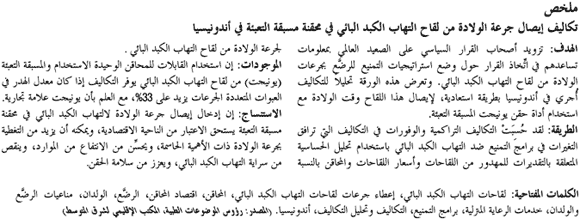
Introduction
WHO recommends the administration of a birth dose of hepatitis B vaccine in countries in which a high proportion of chronic hepatitis B infections are acquired perinatally (e.g. in south-east Asia) (1). The effectiveness of a home-delivered birth dose of hepatitis B vaccine in reducing perinatal disease transmission was demonstrated in the 1980s in Indonesia, where hepatitis B vaccination within 7 days of birth reduced carrier rates among children from 6.2% to 1.4% (2). Although these findings resulted in a national policy endorsing hepatitis B immunization at birth for all of Indonesia's newborns, no suitable strategy for implementation was immediately identified that would reach the high proportion of infants in Indonesia delivered at home (national average is 79% home births) (3). A trial of administration of the birth dose of hepatitis B vaccine at home, using multidose vials and disposable syringes, was conducted in one province; however, wastage rates of 70% were reported (4). In addition, concerns were raised about the possibility of syringe reuse in the uncontrolled setting of home visits. Guaranteeing injection safety while reducing wastage of multidose vials was considered a prerequisite to the introduction of a broader hepatitis B birth-dose immunization programme by the Indonesian Ministry of Health. Standard syringes and multidose vials did not meet their requirements.
In 1995, Uniject, a single-dose, auto-disable injection device, prefilled with hepatitis B vaccine (HB-Uniject), was introduced in a pilot programme. The device was shown to prevent syringe reuse and eliminate wastage of multidose vials. Acceptability and seroconversion studies demonstrated its potential for safe and effective use in newborns at home (57). To improve the timeliness of the birth dose, midwives stored the devices in their homes, out of the cold chain, and took them directly to the homes of newborns to provide a hepatitis B birth dose as part of their routine neonatal home visits. Vaccine vial monitors were included on all devices to detect excessive heat exposure during storage and outreach without a cold chain.
The Indonesian Ministry of Health compared the advantages and disadvantages of the device with those of multidose vials. The results of this comparison are summarized in Table 1. In 1996, Indonesia adopted a policy of using HB-Uniject for all hepatitis B immunizations. By 2000, local filling capacity had been established, and Indonesia was able to introduce a programme for using the device for the birth dose in seven of its provinces. By 2003, the programme had been expanded to target all of Indonesia's five million annual births.
The cost analysis presented in this paper was conducted in 2002 to estimate the incremental costs of adding the device to current neonatal home visit programmes in three Indonesian provinces. In the HB-Uniject introduction programme, the 5-dose vials and disposable syringes were replaced by the device for all three doses. Programmatic impact was assessed and a cost analysis performed.
Methodology
Data collection methods
Data and information on costs were collected as part of a broader evaluation of a programme to improve the safety and effectiveness of hepatitis B immunization in Indonesia through the introduction of HB-Uniject in three of its provinces (4). A retrospective analysis of financial records and project expense reports provided the data required to calculate the incremental cost of expanding immunization coverage with the device. To fully capture the economic costs of introducing this device, interviews with Ministry of Health staff, immunization experts and project managers were also conducted to obtain information on the resources used at each level of the health service delivery system. A micro-costing approach based on the collection of data on the quantity and unit cost of resources consumed was used to estimate the incremental cost associated with introducing HB-Uniject devices into existing immunization services. Incremental cost refers to the change in costs resulting from introducing the device for a birth dose of hepatitis B vaccine given in the home. The analysis provided information on incremental costs or cost savings associated with the hepatitis B immunization programme and used sensitivity analysis to vary the estimates of vaccine wastage rates, coverage rates, and price of the hepatitis B vaccine and injection devices.
Study population
The study took place in three provinces in Indonesia: East Java, West Nusa Tenggara (NTB), and Yogyakarta (DIY), where the HB-Uniject birth-dose strategy had been introduced as part of the routine health-care system in 2000. The analysis of incremental costs resulting from introduction of the device is for the 1-year period, from August 2000 to July 2001, during which approximately 1.2 million doses of hepatitis B vaccine were delivered in the devices. Table 2 provides information by province, on the number of districts, health centres, trained personnel and target newborns for the areas that participated in the introduction programme.
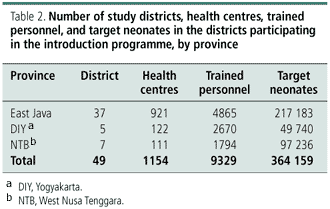
Definitions of costs
The cost data presented here represent the start-up and recurrent costs that changed as a result of introducing HB-Uniject devices for the birth dose. Costs that did not change as a result of using the devices were not included in the analysis. Data on some of the recurrent costs were obtained for two districts in East Java, and standard recurrent costs were determined for NTB and DIY, after adjusting for some minor differences in transport costs between the three provinces. All cost data were collected in the local currency (rupiah) and converted to 2001 US dollars using an exchange rate of US$ 1.00 = Rp. 9800. The cost data represent the costs to the government of implementing these programmes.
Start-up costs
The introduction of HB-Uniject devices required start-up, preparatory and planning activities at the central, provincial and district levels before the intervention could be implemented. In addition, one training session and one awareness-raising meeting was conducted at each level. The costs of planning activities, and the training and awareness-raising activities are start-up costs that were treated as a special case of nonrecurrent capital costs because they were inputs that were one-time in nature and lasted longer than 1 year. It was assumed that training and awareness-raising activities would affect the health personnel over a 5-year period. Start-up costs were divided by 5 years to give an annual estimate for inclusion in the incremental cost analysis.
Injection equipment, vaccine costs and vaccine wastage rates
HB-Uniject prefill injection devices were manufactured by, and filled with vaccine by, Bio Farma, a vaccine manufacturer in Bandung, Indonesia. Bio Farma provided the devices to provinces through the same distribution channels it used for all routine vaccines used in the Indonesian Expanded Programme on Immunization. All the devices were supplied with a vaccine vial monitor to check for heat exposure. The cost of vaccines used in the analysis was calculated as the difference between the cost of hepatitis B vaccine in 5-dose vials and the cost of the devices, including a wastage factor for each. Vaccine prices are shown in Table 3. The costs of disposable syringes are saved when the HB-Uniject devices are used. The present analysis used a conservative estimate of US$ 0.07 for the price per disposable syringe. In Indonesia, all syringes and vaccines, including Uniject devices, are domestically produced and provided, and therefore the prices used in this analysis do not reflect international prices, which may be lower (8).
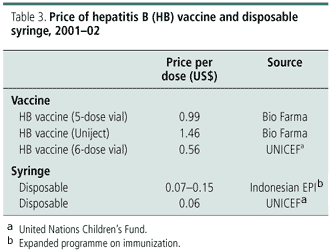
Sensitivity of the results to different assumptions on wastage rates, the price of hepatitis B vaccine in multidose vials, and the price of the device were also calcutated. To capture the variability across different wastage rates between clinic and outreach sessions, sensitivity analysis was performed at 26, 40 and 60%. For comparability to other low-resource settings, sensitivity of the results using the international price for hepatitis B vaccine in multidose vials and auto-disable syringes was analysed.
Disposal costs
The introduction of the programme for delivery of the birth dose during the neonatal home visit incurs the additional cost of safety boxes, their transportation and disposal of the devices by burning. Most health centres do not have incinerators or protected sites for burning used injection devices. It was observed that Uniject devices used by the midwives during the home visit were mostly disposed of locally and never transported to the health centre. To incorporate the additional costs of safe disposal of Uniject devices used by the midwives, this analysis included the additional disposal costs of US$ 0.007 per injection for the birth dose given during the home visit. This price includes the cost of fuel needed to dispose of one injection device (8).
Cold-chain and transport costs
Because the device requires approximately eight times the cold-chain volume of a dose of vaccine in a 10-dose vial, the study assessed whether the current cold storage capacity could accommodate its introduction. No additional burdens to cold-chain or transport system capacity were reported at the provincial or district level. However, in some cases distribution frequency was increased to handle the larger volume. Additional cold boxes for transporting the devices were required at the subdistrict level and these costs were included in this analysis.
The government procures hepatitis B vaccine, in common with all vaccines used in the Indonesian EPI, from Bio Farma at a price that includes distribution to the provincial stores. Therefore, the cost of transport of vaccine from the centre to the provincial level is included in both the costs of the 5 dose vial and of the device.
Results
Impact on immunization coverage and vaccine wastage rates
Indonesian policy considers the birth dose of hepatitis B vaccine to be most effective if it is administered to the infant within 7 days of birth. All figures for birth-dose coverage reported here are for doses administered within 7 days of birth. Prior to the introduction of HB-Uniject, the birth dose of hepatitis B vaccine was mainly administered to neonates using multidose vials in hospitals and maternity clinics, and national coverage was less than 5%. One province, NTB, had implemented a home-visit birth-dose programme during the 5 years prior to the introduction of the device and had achieved a birth-dose coverage rate of 68%.
The programme demonstrated that coverage of the critical birth dose can be increased (Table 4). The administration of the birth dose in East Java and DIY began with the introduction of the HB-Uniject device programme in 2000. Before the programme started, infants received their first dose of HB vaccine at age 6 weeks, when they visited the health centre for the first diphtheriapertussistetanus vaccination (4). After 2 years of the programme, birth-dose coverage reached 38.3% in East Java and 85.8% in DIY. NTB province increased its birth dose coverage rate from 68% to 80%.
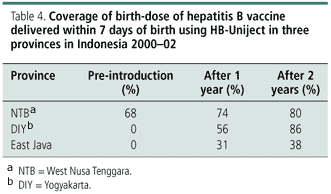
The vaccine wastage rate of the device was less than 1% (0.005%) (4). This represents a significant improvement over the wastage rates associated with use of multidose vials. Indonesian data for home delivery of a birth dose using a syringe and 5- and 10-dose vials were limited to the only province in which this strategy had been attempted. NTB province used 10-dose and then 5-dose vials of hepatitis B for home visits for 5 years prior to the introduction of the device. Due to the Indonesian policy of discarding opened vials of vaccine at the end of a day, when used for outreach, the reported vaccine wastage rate was 70% (4). When used in monthly immunization sessions, as opposed to home visits, the hepatitis B wastage rates for Indonesia were 26% for 5-dose vials and 31% for 10-dose vials. The baseline wastage rate used in the present analysis was 31%.
Personnel costs
Because trained midwives were already posted in each village and already received travel allowances for performing home visits to neonates, the logistics and personnel costs of delivering the first dose of hepatitis B vaccine at home were small. The additional cost of providing hepatitis B vaccine using the Uniject device was US$ 0.05 per home visit. About 18% of the cost increase was attributable to personnel costs, including the midwife's time to reach the child at home. Other travel-related costs accounted for 75% of the increase, and the remaining 7% was attributable to equipment, such as the cost of the vaccine carrier box.
Overall incremental programme costs
The baseline scenario, using a 31% wastage rate, generates a small incrementally higher cost from using the Uniject device than for using multidose vials and disposable syringes. For the three provinces studied, the device adds an average cost of around US$ 0.04 per child effectively vaccinated with the hepatitis B birth dose, or a net cost to the government of US$ 5870 per year (Table 5, web version only, available at: http//www.who.int/bulletin). The device does not generate any additional recurrent cost per dose. However, including the start-up costs contributes to an overall net cost. The majority of the cost savings for recurrent costs come from replacing the multidose vials with the devices. Although the gross cost per injection is less for vaccine and disposable syringe than for the Uniject device (Table 5, web version only, available at: http//www.who.int/bulletin), adjusting for wastage for both vaccine and syringes reduces any price advantages.
The differences in coverage across East Java, DIY and NTB help to demonstrate the impact of increasing coverage on total, recurrent and incremental costs. As coverage of birth dose of hepatitis B vaccine increases, total costs will also increase; however, because 20% of the total costs of the programme are start-up costs, as coverage increases, these fixed, one-time costs are distributed among a larger number of fully immunized children. Increasing the coverage of the birth dose of hepatitis B vaccine reduces the incremental costs of introducing the vaccine in the Uniject device. Cost savings increase marginally as coverage increases. NTB and DIY, which both have higher coverage rates than East Java, have lower incremental costs per child immunized with a birth dose of the hepatitis B vaccine in the device. Using midwives to deliver this vaccine in the Uniject device uses existing resources more efficiently and strengthens the existing midwife programme for neonatal home visits (4).
Sensitivity analysis
The univariate sensitivity analysis revealed that incremental costs were sensitive to changes in the price of the hepatitis B vaccine in multi-dose vials, changes in the price of the hepatitis B vaccine in the device (Table 6), and changes in vaccine wastage rates (Table 7). If the world price of US$ 0.56 for the vaccine in the multidose vial is used, the incremental cost of introducing the HB-Uniject device is US$ 0.67 per child effectively vaccinated with the birth dose of hepatitis B. Vaccination using the device becomes cost-saving when the price of the device is reduced by 25%.

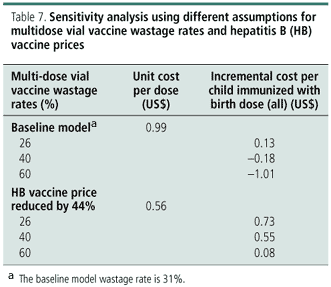
The results of the analysis based on different vaccine wastage rates of 60, 40 and 26% are presented in Table 7. Using scenarios based on higher or lower wastage rates highlights the importance of wastage rates, in addition to price, in influencing programme costs. Using a conservative estimate of 26% vaccine wastage increases the incremental cost to US$ 0.13 per immunized child. At wastage rates of 40% and 60% the use of the devices is cost-saving. Additional analysis showed that the introduction of the devices, and using midwives to deliver the birth dose at the home of the neonate is cost-saving when wastage rates for multidose vials are greater than 33%. Using the world price of US$ 0.56 for hepatitis B vaccine in multidose vials, the incremental cost per child immunized ranges from US$ 0.73 to US$ 0.08 for wastage rates between 26% and 60%. The hepatitis B vaccine in the Uniject device would become cost-saving at either a wastage rate of 70% or at a higher world price of US$ 0.60.
Discussion
Hepatitis B vaccination, when the first dose is delivered as soon as possible after birth, has been demonstrated to be effective in reducing mother-to-infant transmission of the disease. In areas of high endemicity, the birth-dose strategy is recommended by WHO (1). However, many of the countries in which hepatitis B is endemic also have a high proportion of home births, poor health infrastructure and limited financial resources. To meet the need for a birth dose and overcome these challenges, Indonesia embarked on a research, evaluation and introduction programme to enable all newborns to be immunized with hepatitis B vaccine during their first week of life.
HB-Uniject, delivered by midwives who store the vaccine in their homes, was selected as the most practical and cost-effective strategy for delivering the birth dose in Indonesia. The present incremental cost analysis showed that the use of village midwives to administer a birth dose using the Uniject device during a home visit is cost-saving when the wastage rates of the multidose vial alternative are more than 33%. Because the wastage rates determined in the one province in which Indonesia had attempted to conduct home delivery of the birth dose with multidose vials was 70%, the device would be cost-saving in similar settings. In addition to the cost benefits of the HB-Uniject strategy, there is a significant health benefit from the substantial increase in birth-dose coverage, specifically in the reduced rates of maternal transmission of hepatitis B. Elimination of the possibility of reusing syringes is also an important health benefit of auto-disable syringes such as the Uniject device. The main factors influencing incremental programme costs were found to be the price of hepatitis B vaccine, single-dose presentation and wastage rates.
Overall, the introduction of hepatitis B vaccine in the devices is economically worthwhile, as it can increase coverage of the critical birth dose using existing resources and also increase health benefits through reduced transmission of hepatitis B and promotion of improved injection safety. At the community level, delivering this vaccine in the Uniject device uses existing resources more efficiently and can strengthen existing outreach programmes such as Indonesia's programme for neonatal home visits (4).
A factor critical to the feasibility of providing the HB-Uniject birth dose in Indonesia was the availability of trained midwives in every village. Countries without community-level vaccinators face a greater challenge. However in such situations, the device may offer opportunities for programmmatic innovations to overcome a shortage of community-based health personnel. For example, Afghanistan and Mali have recently conducted tetanus toxoid vaccination campaigns using tetanus toxoid-filled Uniject devices. Because of the ease of use and built-in safety features of this device, traditional birth attendants and other community members were successfully trained and organized to administer tetanus toxoid immunization in their communities. The results showed not only that midwives were capable of giving injections using the device, but also that they were able to dramatically increase vaccination coverage by reaching women within their communities in door-to-door campaigns (BASICS, UNICEF, unpublished report).
By quantifying the incremental costs of introducing HB-Uniject, we hope to provide critical information for other countries interested in identifying the most effective approach for the introduction of the hepatitis B vaccine birth dose. Although world vaccine prices are generally lower than the Indonesian prices analysed here, the ratio of price per dose administered from a multidose vial to price per dose administered with the device is expected to remain similar, and thus the cost model should be generally applicable to other vaccine pricing scenarios. The added programmatic and safety benefits offered by HB-Uniject are less quantifiable, but nonetheless substantial. Indonesia could not have easily or cost-effectively implemented a nationwide birth-dose programme for hepatitis B vaccination with multidose vials and disposable syringes. 
Acknowledgements
We thank Steve Brooke and Sophie Newland who were key in shaping the outline of the study, collecting information and reviewing the document. We would also like to thank several anonymous reviewers for their helpful comments.
Funding: This study was funded by the Children's Vaccine Program of the Program for Appropriate Technology in Health (PATH). The Uniject device was developed by PATH under the HealthTech Program, Cooperative Agreement No. GPH-A-00-01-00005, supported by the United States Agency for International Development, then licensed to BD in 1996.
Competing interests: none declared.
References
1. World Health Organization. Immunization, vaccines, and biologicals. Geneva: WHO; 2003. Available from: URL: http://www.who.int/vaccines/en/hepatitisb.shtml
2. Ruff TA, Gertig DM, Otto BF, Gust ID, Sutanto A, Soewarso TI, et al. Lombok hepatitis B model immunization project: toward universal infant hepatitis B immunization in Indonesia. Journal of Infectious Diseases 1995;171:290-6.
3. Central Bureau of Statistics (Indonesia), State Ministry of Population/National Family Planning Coordinating Board, Ministry of Health and Macro International Inc. Indonesia demographic and health survey 1997. Calverton (MD): Central Bureau of Statistics and Macro International; 1998.
4. Ministry of Health/Center for Disease Control. Improving the safety and effectiveness of hepatitis B immunization in Indonesia through Uniject-HB introduction in D.I. Yogyakarta, East Java, and West Nusa Tenggara Provinces. Final report. Jakarta: Immunization Subdirectorate, Directorate Epim & Kesma, Directorate General CDC & Environmental Health/Program for Appropriate Technology in Health; 2002.
5. Otto BF, Suarnawa IM, Stewart T, Nelson C, Ruff TA, Widjaya A, et al. At-birth immunisation against hepatitis B using a novel pre-filled immunisation device stored outside the cold chain. Vaccine 1999;18:498-502.
6. Anwar C. Cost effectiveness analysis. Pelaksanaan Imunisasi Hepatitis B Dengan Penggunaan Alat Suntik Uniject dan Alat Suntik Sekali Pakai (Disposable) de Kabupaten Bantul, Year 2000. [Cost-effectiveness analysis. Hepatitis B immunization using Uniject and disposable syringe in Bantul District in 2000] [thesis]. University of Indonesia; 2001.
7. Sutanto A, Suarnawa IM, Nelson CM, Stewart T, Soewarso TI. Home delivery of heat-stable vaccines in Indonesia: outreach immunization with a prefilled, single-use injection device. Bulletin of the World Health Organization 1999;77:119-26.
8. Thabrany H, Nadjib M, Sakagawa B. Comparative costs of alternative presentations of HepB-DTP vaccines in AD syringes and Uniject injection devices to ensure safe injections in Indonesia. Abstract. San Francisco: Fourth iHEA World Congress on Health Economics;2003.
(Submitted: 22 December 2003 Final revised version received: 22 December 2004 Accepted: 23 December 2004)
1 Correspondence should be sent to Dr Levin at this address (email: clevin@path.org).
